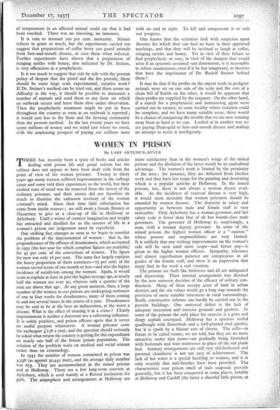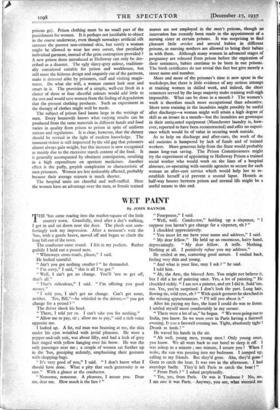WOMEN IN PRISON
By LADY ARTEMUS-JONES
THERE has recently been a spate of books and articles dealing with prison life and penal reform but the subject does not appear to have been dealt with from the point of view of the woman prisoner. Twenty to thirty years ago many women suffered imprisonment in the suffrage cause end some told their experiences to the world, but their exalted state of mind was far removed from the misery of the ordinary prisoner, and their stories did not therefore do much to illumine the unknown territory of the woman criminal's mind. Since their time little information has come from inside sources ; we still await a female Benney or Macartney to give us a close-up of life in Holloway or Aylesbury. Until a writer of creative imagination and insight has extracted and distilled for us the essence of life in a woman's prison our judgement must be superficial.
One striking fact emerges as soon as we begin to consider the problem of the imprisonment of women : that is, the preponderance of the offence of drunkenness, which accounted in 1935 (the last year for which complete figures are available) for 45 per cent. of the convictions of women. The figure for men was only 16 per cent. The same fact largely explains the heavy proportion of short sentences-73 per cent. of the women served terms of one month or less—and also the higher incidence of recidivism among the women. Again, it would seem to explain at least in part the higher average age, as nearly half the women are over 3o, whereas only a quarter of the men are above that age. At any given moment, then, a large number of the women in our prisons are undergoing sentences of one to four weeks for drunkenness, many of them coming in and out several times in the course of a year. Drunkenness may be said to be at the best an indiscretion, at the worst a disease. What is the effect of treating it as a crime ? Clearly imprisonment is neither a deterrent nor a reforming influence. It is solely punitive, and prison officers agree that it serves no useful purpose whatsoever. A woman prisoner costs the exchequer L158 a year, and the question should seriously be asked what return the country is getting for this expenditure on nearly one half of the female prison population. The solution of the problem waits on medical and social science rather than on criminology.
In 1935 the number of women committed to prison was 4,338 (as against 30,445 men), and the average daily number was 653. They are accommodated in the mixed prisons and at Holloway. -There are a few long-term convicts at Aylesbury, which is used mainly as a Borstal institution for 8iFls." The atmosphere and arrangements at Holloway are more satisfactory than in the women's wings of the mixed prisons and the abolition of the latter would be an undoubted advantage. The women's work is limited by the proximity of the men ; for instance, they are debarred from kitclien work and they have less 'Scope for the painting and decOrating which is a poPUlar activity at Holloway. In the mixed prisons, too, there is -not always a woman doctor avail- able. As the incidence of venereal disease is very high, it would seem desirable that women prisoners should be attended by women doctors. The disparity in salary and opportunity as between male and female staff is very noticeable. Only Aylesbury has a woman governor, and her salary scale is lower than that of all but fourth-class male governors. The governor of Holloway is, surprisingly, a man, with a woman deputy governor. In some of the mixed prisons the highest woman officer is a " matron " whose powers and responsibilities are very limited. It is unlikely that any striking improvements on the women's side will be seen until more scope—and better pay—is given to the higher women officers. Sympathy, tolerance and almost superhuman patience are conspicuous in all grades of the female staff, and there is an impression that many find in the work a real vocation.
The prisons are built like fortresses and all are antiquated and depressing. Their internal arrangement was dictated by the now outworn doctrine of the efficacy of solitary con- finement. Many of them occupy acres of land in urban districts and the site values Would go a long way towards the provision of more suitable structures in rural surroundings. Really constructive reforms can hardly be carried out in the present buildings. One universal defect is the lack of adequate recreation and exercise grounds and gardens. In some of the prisons the only place for exercise is a grim and dingy asphalt courtyard. Holloway has a spacious turfed quadrangle with flowerbeds and a well-planted rock garden, but it is spoilt by a blatant row of closets. The cells—in futirre to be called rooms, we are told, but they are no more attractive under that name—are gradually being furnished With bedsteads and wire mattresses in place of the old plank bed. Sanitary arrangements are still very old-fashioned and personal cleanliness is not too easy of achievement. The lack of hot water is a special hardship to women, and it is only recently that nail-brushes have been provided. The characteristic sour prison smell of stale soapsuds prevails generally, but it has been conquered in some places, notably at Holloway and Cardiff (the latter a cheerful little prison, as prisons go). Prison clothing must be no small part of the punishment for women. It is perhaps not justifiable to object to the coarse underwear, even though nowadays artificial silk caresses the poorest non-criminal skin, but surely a woman might be allowed to wear her own corset, that peculiarly individual garment, instead of the grim contraption provided ? A new prison dress introduced at Holloway can only be des- cribed as a disaster. The ugly slatey-grey colour, tradition- ally considered suitable for prison and workhouse, but still more the hideous design and ungainly cut of the garment, make it detested alike by prisoners, staff and visiting magis- trates. Do what she will, a woman cannot look neat and smart in it. The provision of a simple, well-cut frock in a choice of three or four cheerful colours would add little to the cost and would save women from the feeling of degradation that the present clothing produces. Such an experiment in the therapy of clothes might well be made.
The subject of prison food looms large in the writings of men. Every housewife knows what varying results can be produced from the same materials in different hands and food varies in quality from prison to prison in spite of uniform rations and regulations. It is clear, however, that the dietary should be revised in the light of modern knowledge. The innocent visitor is still impressed by the old gag that prisoners almost always gain weight, but this increase is now recognised as mainly due to the excessive starch content of the food. It is generally accompanied by obstinate constipation, resulting in a high expenditure on aperient medicines. Another effect is the puffy, greyish complexion so characteristic of men prisoners. Women are less noticeably affected, probably because their average sojourn is much shorter.
The hospital units are cheerful and well-staffed. Here the women have an advantage over the men, as female trained nurses are not employed in the men's prisons, though an innovation has recently been made in the appointment of a nursing sister at certain prisons. It was surprising 110 find pleasant little creches and several babies in different prisons, as nursing mothers are allowed to bring their babies in with them. Although many women in advanced stages of pregnancy are released from prison before the expiration of their sentences, babies continue to be born in our prisons. The birth certificates do not reveal this fact but give merely a street name and number.
More and more of the prisoner's time is now spent in the workshops, but there is little evidence of any serious attempt at training women in skilled work, and indeed, the short sentences served by the large majority make training well-nigh impossible. What can be done in a month ? The women's work is therefore much more occupational than educative. Short term training in the laundries might possibly be useful after discharge—a woman might well attain a high degree of skill as an irouer in a month—but the laundries are grotesque in their antiquated equipment (Manchester laundry is, how- ever, reported to have been reconstructed) and offer no experi- ence which would be of value in securing work outside.
As to help on discharge and after-care, the work of the aid societies is hampered by lack of funds and of trained workers. More generous help from the State would probably mean long-run saving. The Prison Commissioners might try the experiment of appointing to Holloway Prison a trained social worker who would . work on the lines of a hospital almoner, co-operating with outside agencies to secure for each woman an after-care service which would help her to re- establish herself a id prevent a second lapse. Hostels as half-way houses between prison and normal life might be a useful means to this end.















































 Previous page
Previous page